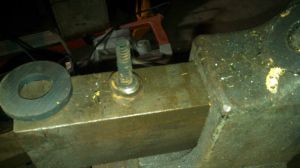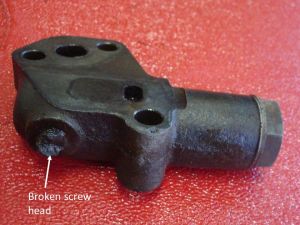- Home
- About Us
- Join/Renew
- Member Benefits
- Member Pages
- Log In
- Help
- Museum Store
I think I should disassemble my oil pressure regulator – the one mounted to the oil pump – to inspect and clean. The Floto screen I showed in my picture in a previous message certainly indicates likely corrosion and sludge issues.
The screw that I assume holds a spring and check ball in the regulator has the head broken and I will have to extract it. My question is: is the max oil pressure relief setting based on the position of that screw that I will lose once I pull it out?
Thanks for any help.
Jim
Hi Jim, the pressure that the regulator, or relief valve is set at can be reproduced if you count the threads of the screw that are threaded into the valve body. If you use the same spring, you should have close to the same pressure.
I have one or two of those pump-mounted relief valves on a work bench somewhere, I’ll find one and take a look at it, and see if I can figure out a way to set the adjustment prior to installing it in the engine.
Greg Long
Hi Jim, I looked at two different pumps with pressure regulators, neither had an adjustment, both have a 1″ hex head plug in the relief bore.
The plug has a hollow inside to hold the relief valve spring. The other end is a small piston, with a recess in the base to locate the spring.
Here is first of two images:
Greg Long

Here is an image of the hex-head plug that is in the upper left corner in the previous photo. When removed, her is the inside end of the plug with the spring in place.
There is a square headed plug at the opposite end of the bore int the valve, it has 1/8″ pipe threads, I’m sure this is a port for a pressure test or setup of the valve.
The only way to adjust the pressure setting would be to use a different spring, or add shims under the spring on either end, or use a different piston for the other end of the spring.
Jim: is this the same plug as you need to remove on your pump?

Jim: Inspect the spring to assure that it doesn’t show wear around the sides. I had this problem with my 845. After replacing the spring, all is well. With the engine well warmed up it runs at 42 psi at 40 mph. To check the pump, we attached a pressure gauge to the output side, placed the pump in a pan of 10 wt. oil and turn it with the crank from a socket set to check the output pressure. A bit crude, however, it worked.
Thanks guys, I feel pretty stupid at the moment, I was so focused on the broken screw head last Sunday I didn’t realize the great big cap screw with shim washer was what would have the spring and check valve. Duh! I have the big cap screw and spring removed now and soaking in solvent. A fair amount of sludge, I’m not sure yet if there is corrosion or wear.
If you guys think the function of the plug with broken head is just to seal a pressure check port then it seems like I can probably leave it alone and get everything cleaned up without trying to extract it. The idea of checking by turning the pump before installing in the engine is a good idea. Thanks!
Jim

